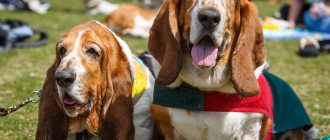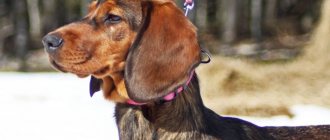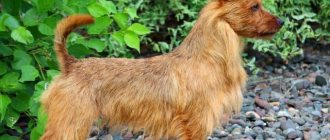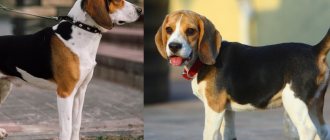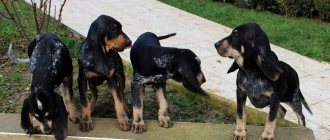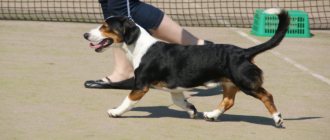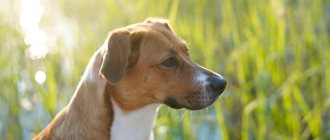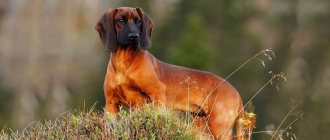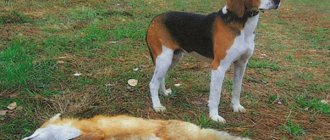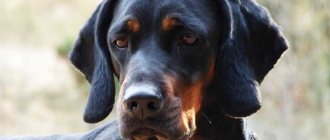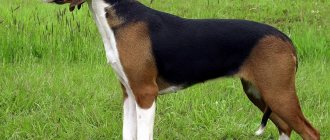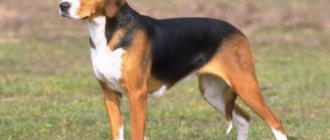Austrian Brandlbracke, Austrian Smoothhaired Hound, Austrian Hound, Carinthian Brandlbracke, Brandlbracke, Austrian Hound, Brandlbracke, Austrian Smoothhaired Hound)
The Austrian Hound is not a very common breed today and is found quite rarely, most often only in Austria itself. The Brundle Brakk is generally a very capable hunter who will not stop pursuing the prey until he finally drives it into a trap.
The hunting habits of this hound are manifested not only during hunting, but also in everyday life. The Brundle Brakk is a very stubborn breed and will get its way no matter what.
History of the breed
The history of the Austrian hound remains a mystery.
Almost all sources claim that the ancestors of the breed were Celtic dogs, called in German (language and Austria) “Kelten Brake”. Although most of Austria was inhabited by Germanic tribes since the fall of the Roman Empire, Celtic tribes, the same as those in Switzerland, France, and Belgium, also lived in it.
In addition, according to the descriptions, they are very different from each other. Even if this relationship existed, over hundreds of years the Austrian hound mixed with other breeds and became very different from its ancestor.
But, no matter where they came from, these dogs are very popular in Austria, especially in the mountainous regions. For many years they were not purebred, but mixed with other breeds, but in 1884 the Australian hound was recognized as a separate breed, and a standard was written.
In its homeland, it is widely known as “Brandlbracke”, which can be translated as a fire hound, based on its coat color. Smooth-haired Brackets were used in hunting rabbits and foxes, tracking down larger animals, usually in small packs.
At one time, Austrian Brackets were kept only by the nobility, as was the case with many dogs in Europe. Only the nobility had hunting rights on their territory; it was a popular pastime and hunting dogs were highly valued.
Unlike many modern dogs, the Austrian Hound is still used as a hunting dog today, and will remain so for the foreseeable future.
Brief historical background
There is no reliable historical data on the origin of the Austrian hound, so it is not possible to say exactly when it arose. The Celtic hound is considered to be the ancestor of the Brandl Brack, but this is only an assumption; no documentary evidence of this fact has been found so far.
Endemic dogs of a similar type lived for many years in the Austrian mountains, freely interbreeding with local aboriginal breeds. Until the middle of the 19th century, no one was breeding them. But already in 1884 the first breed standard was described, and from that time on the mixing of different types of dogs stopped. Since then, the Austrian Bracket has been bred in purity.
The international canine community recognized the breed in 1954. It is entered in the FCI register under number 63 (group 6 - hounds, bloodhounds and related breeds, section 1.2 - medium-sized hounds). The current and most current version of the standard dates back to June 18, 1996.
The Austrian Hound is very little known outside of its homeland.
The Austrian Hound is widely known only in its historical homeland. Outside of Austria it is practically never found.
Character
Born to work in a pack, Austrian hounds are very calm towards other dogs and even prefer their company. But, as a hunting dog, they are very aggressive towards other small animals, and can chase and kill them.
I recommend: Russian Hortaya Greyhound: fast and agile
Smooth-haired Brackets do not tolerate life in the city very well; they need a spacious yard, freedom and hunting. Moreover, during the hunt they give a vocal signal about the discovered prey, and as a result are more vocal than other dogs.
Advantages
The main advantages of the Australian hound are its keen sense of smell, jumping ability, and tenacity. A dog of this breed does not experience fear and can follow the trail of its prey very quietly, almost silently. The dog is used for all types of hunting and can confidently be called a universal hunting dog.
The lifespan of the Australian hound is about 13 years.
Sources
- https://sobakainfo.ru/avstrijskij-brudastyj-brakk-opisanie-xarakteristika-uxod-foto/
- https://sobakainfo.ru/avstrijskaya-gonchaya-brandl-brakk-opisanie-s-foto/
- https://dogipediya.ru/porody-sobak/bolshie/avstrijskaya-gonchaya
- https://dk-sobolevo.ru/drugoe/avstralijskaya-gonchaya-5-bukv.html
- https://dog.pet2me.com/ru/breed/Avstraliyskaja_gonchaja/
- https://prohvost.club/sobaki/porody-sobak/avstriyskaya-gonchaya-foto.html
- https://promislovik.info/poroda-brakk/
- https://usatiki.ru/avstrijskaya-gonchaya/
- https://aquarium-fish-home.ru/sobaki/avstrijskaya-gonchaya-istoriya-i-standart-porody/.html
[collapse]
Socialization
Noisy but not aggressive dog. The Austrian Bracket gets along well with his own kind. The dog hunts in a pack, so he is absolutely accustomed to his relatives.
The pet is friendly with strangers, but acts aloof. If you pet him, he will endure it; he will not impose himself with affection.
Like any self-respecting hunter, he considers living together with other animals beneath his dignity. The cats will be instantly strangled. There will be no wet place left from rodents.
general characteristics
Not tall, fast, lean, rough-haired, does not require special care. All the most necessary qualities were embedded in her. Born hunters. Universal, can work on any terrain. Not aggressive, loyal to one owner. Easy to train, smart. Care is very simple, just brush your pet periodically. Treats all family members kindly, including children.
Features of maintenance and care
The Austrian Smooth-haired Bracket is easy to care for. He is able to be content with little. This does not mean that you can give up on the dog. There are some requirements for its content.
Combing
The pet is brushed several times a week. Dead hairs are removed so that the dog does not scatter them around the enclosure.
During shedding, the Austrian Hound needs daily grooming.
Bathing
The animal practically does not need it. Wool has self-cleaning properties. Twice a year is enough for water procedures. If your pet gets very dirty, you will have to wash it.
Walk
Running after a ball or puller will be the best entertainment during a walk.
Where is the best place to buy a purebred hunting dog?
It is best to purchase a purebred hunting puppy, of course, from a specialized nursery; this is a guarantee that the puppy will be absolutely healthy, with an excellent pedigree, vaccinated and with all the relevant documents.
The Austrian Smooth-haired Bracket breed is very hardy and is capable of chasing an animal for several hours in a row, or even driving it down until the animal falls from exhaustion.
In addition, you can always ask for advice on raising a puppy. If you save money and buy a puppy from random people, then you can buy a sick animal, an unknown breed without documents and certainly without a pedigree, which may well not have a hunting instinct. Such a purchase will inevitably lead to bitter disappointment.
Description of the Austrian Hound
Brandle Brackets are kept extremely rarely as pets and companion dogs.
Appearance
The body of the Austrian Hound is muscular and strong, but rather graceful and fine-boned.
The Austrian Black and Tan Hound moves easily and gracefully. Thanks to its lightweight frame, it has excellent jumping ability.
The Austrian Hound moves easily and lithely
Disadvantages and disqualifying vices
The following are recognized as defects or deficiencies:
The reasons for disqualification will be:
Character and psyche of the breed
The Austrian Hound needs to exercise a lot.
Only a real hunter or a professional huntsman should have such a pet.
The poorly developed territorial instinct does not allow the use of hounds as guards. Although they perceive uninvited strangers with suspicion, they do not possess the necessary aggressiveness.
Hunting
The French Braque is a faithful companion and an excellent hunter. Quadrupeds have developed sense of smell and hearing, instinctively make a firm stance, capable of working hard, but achieving their goals. Representatives of the breed have an innate instinct to fetch, interestingly, but even French Braque puppies are not afraid of shots.
In work they are used as tracking, gun and pointing dogs. Thanks to its short but very dense coat, the French Braque can work for a long time, despite the weather conditions. According to the experience of hunters, dogs show excellent results when working on water, swampy and bushy areas, on plains and even in sand.
Caring for the Austrian Hound
Hounds feel best when free-ranging.
Caring for Austrian Braques is simple, it consists of the following activities:
Real hunters prefer to feed their pets homemade, specially prepared food. The natural diet includes:
It is forbidden to give hounds human food from the common table, as well as fatty, sweet, very salty, peppered, smoked foods.
Training
It is imperative to raise and train the Austrian Hound.
It is better to entrust further training and training to a professional hunter or dog handler.
What to feed?
This breed is not too picky about food, the cost of providing food for an adult pet will not be very high, because the dog is of medium size, you can see this by looking at a photo or video. Beagles do not have a tendency to overeat, but they need a reserve of energy to be able to bear the load.
In order for a dog to develop its muscles and skeleton well, it is important to provide it with a sufficient amount of protein and calcium. A hound's diet should contain the following components (in the case of natural food):
- fats;
- dairy products;
- cellulose;
- meat;
- fat-soluble vitamins.
Hunting with an Estonian hound assumes that the animal will not be fed a day before, but only given water. The main mistake when feeding would be a combination of dry and natural food; this can have a worse effect on the health of your pet. Your pet should always have access to clean water, especially when the temperature outside rises.
Character of the breed
The Austrian Smooth-haired Bracket is a rather angry and aggressive dog. He is always ready to fight back, and in case of provocation he is able to attack first.
Relationships with relatives of the same sex are especially difficult, so you should not keep them together.
The brakk shows respect for the owner's family and tries to protect it in every possible way. Does not like strangers and strangers in the house. In general, the attitude towards people is friendly, but wary. Very loyal to his owner.
The dog is recommended for keeping by gamekeepers and hunters. Not suitable as a regular pet.
Choosing a puppy
What should a “gonchak” be like? Active and curious. It is better to take any dog from a kennel. With the exception of hunting ones. They are purchased from professional hunters, and such a puppy costs an order of magnitude cheaper. But its working qualities are much better than those of its “greenhouse brother”.
The Austrian hound is little known in Russia. There are no nurseries engaged in breeding the breed. Therefore, you can only buy a puppy in Austria.
For those who have decided to take such a brave step, it is important to know: they do not like to sell dogs abroad. Especially good ones to Russia. Asking a breeder for help in choosing a puppy is pointless. The main factors that the buyer relies on are the baby’s attitude to the world around him. How he behaves with his brothers and sisters, how he reacts to strangers, whether he is interested in a new toy just offered. If the puppy is active, is a leader among his littermates, and actively attacks the toy, he will grow up to be a good hunting dog.
Origin
The origin story is quite confusing. According to one version, the ancestor of the breed is the Tyrolean hound. According to the second, the hound from Austria descended from Celtic dogs. These are the closest related breeds. This hypothesis is hardly plausible. The difference between the Celtic Braque and our hound is a thousand years. If, however, Celtic dogs took part in the formation of the Austrian hound, then it is quite distant. The Austrian Hound is completely different from its supposed ancestors. Differences in appearance can be explained by admixtures of new blood. The hound from Austria was shaped not only by Celtic dogs. The genetics of other breeds have taken their toll. Nobody knows if this is true. It is known that the Brandl Brack, as the breed is also called, has become widespread in Austria. And in 1884 a breed standard was created.
The photo shows an Austrian hound.
Section 2. Pivots
Alpine dachshund hound
Description: a rare breed of hunting dog. Bred in Austria, used for hunting wounded deer, wild boars, hares, and foxes.
A medium-sized dog, slightly reminiscent of a dachshund in build, with short legs and a long body. The coat is dense, short, smooth. The eyes are round and expressive. The breed was bred in the mid-19th century.
Height 34-42 cm for males the ideal is 37-38 cm, for females the ideal is 36-37 cm.
Weight 15-18 kg.
Bavarian mountain hound
Description: The ancestor of the Bavarian mountain hound was the Hanoverian hound, which found prey by following blood trails. However, it later turned out that the Hanoverian hound was unsuitable for the mountainous terrain - it worked on a leash, and the owner, following his dog, could fall off a cliff. In the 1870s, Hanoverian hounds were crossed with Austrian and Tyrolean hounds. As a result of this crossing, a mountain hound appeared, which was capable of working in mountain conditions. The breed was recognized in 1912.
The Bavarian Mountain Hound is an elongated dog with an elongated head and a relatively wide skull that is dome-shaped. The transition from forehead to muzzle is well defined. The muzzle is wide, slightly pointed. The jaws are strong. The color of the nose is from black to dark brown. Nose with wide nostrils. The eyes are medium-sized, oval-shaped, with dark eyelids, dark or light brown in color. The ears are small, set high, the tips are rounded, hanging down without folds.
The body is elongated, the neck is of medium length, with a slight dewlap, strong. The chest and back are strong and quite long. The croup is long and straight. The stomach is tucked. The limbs are relatively short, muscular, and the bones are strong. Paws are oval shaped, the pads are pigmented. The tail is of medium length, saber-shaped, set high. The coat is dense, short, not very hard, and fits well to the body. The color is red with all shades and brindle. Sometimes there may be small white spots on the chest. Height at the withers: for males 47-52 cm, for females 44-48 cm. Body weight 20-25 kg.
Personality: The Bavarian Mountain Hound is a bold and energetic dog. She has an excellent sense of smell, which allows her to accurately pursue a shot animal. By nature, Bavarian mountain hounds are obedient, calm dogs, attached to their owner.
Training: Training this dog breed requires an experienced person. They are not adapted to life in the city, as they require great physical activity and living space. They are used as hunting dogs that search for prey using a blood trail.
FCI standard Edit
Head/muzzle.
Small in size relative to the size of the body, the muzzle is narrower than the skull, very slightly pointed, approximately equal in length to the skull.
Eyes.
Small, frontal set, oval.
Ears.
Hanging, elongated (approximately to the nose) with a rounded top, not wide. It takes five to seven months for the ears to develop to full length. At a young age they hang unopened.
Mouth/bite.
The bite is strong, pincer-like.
Neck.
Very strong, wide.
Torso/body.
The chest is wide and deep. The body is wide, bony, with a voluminous, slightly convex chest, and a well-shaped belly.
Limbs.
Wide parallel set with pronounced angulations, dry bony.
Tail.
Medium length - saber-shaped, typical of a hound, set just below the level of the back. Usually lowered, raised only when searching for prey.
Hair (dog hair).
Short, smooth, close-lying, with a dense undercoat.
Color.
Red or brindle, often with a black mask.
Dimensions.
Height at withers. Males - 50-56 cm; Females - 48-54 cm. Weight From 22 to 32 kg.
Disadvantages and disqualifying vices.
Any deviation from the above requirements is considered a fault and its severity is assessed strictly in proportion to the degree of its severity.
Also:
Males must have two normally developed testes, fully descended into the scrotum.
| Dog breeds |
| Australian Short-tailed Cattle Dog • Australian Shepherd • Australian Heeler • Australian Cattle Dog • Australian Kettle • Australian Terrier • Azawakh • Aidi • Alabai • Alano • Alpine Dachshund • American Water Spaniel • English Bulldog • English Coonhound • English Springer Spaniel • Appenzeller Mountain Dog • Affenpinscher • Greater Swiss Mountain Dog • White Swiss Shepherd • Barbet • Bergamasco Shepherd • Bichon Frize • Beauceron • Catahoula Bulldog • Buryat Mongolian Wolfhound • Welsh Corgi • West Highland White Terrier • East European Shepherd • Havanese Bichon • Gampr • Dutch Smoushond • Blue Gascony Basset • Dalmatian • Dandie Dinmont Terrier • Doberman Pinscher • Longhaired Collie • Drathaar • Eurasier • Wire Fox Terrier • Golden Retriever • Irish Water Spaniel • Yorkshire Terrier • Cane Corso • Kerry Blue Terrier • Cairn Terrier • Cromforlander • King Charles Spaniel • Shorthaired Collie • Komondor • Kuvasz • Kurzhaar • Labrador Retriever • Langhaar • Lhasa Apso • Mallorcan Shepherd • Maltese • Miniature Schnauzer • Pug • Moscow Watchdog • German Boxer • Auvergne Pointer • Otterhound • Puggle • Pekingese • Pyrenean Shepherd • Poodle • Puli • Pumi • Samoyed • Saint-Germain Braque • Slovakian Dude • Dachshund • Husky • Hovawart • Croatian Shepherd • Miniature Schnauzer • Chinook • Chihuahua • Swedish Lapphund • Shih Tzu • Sheltie • Sholoitzcuintle • Entlebucher Mountain Dog • Estrela Shepherd • Jagdterrier • Japanese Chin |
Key points in training
These dogs are hunters by genetics and temperament. They are serious, stubborn and independent. To raise a good pet you need to have a strong character. A beginner cannot cope with such a dog.
Such a dog needs to be trained from 3-4 months, but raised from birth. The pet must know that the person in the house is in charge and must be obeyed. To do this, you should not allow the puppy to jump on the owner’s furniture, beg, manipulate, or whine for no reason. The owner always needs to remain a leader and show this to the dog. But you cannot resort to harsh methods: hitting your pet, insulting, humiliating. To show the hound that she is wrong, you can pull the collar, deprive her of treats or food.
Basic commands are learned by the puppy after he has memorized his name. By 4 months, the dog should respond to its name, know the walking and feeding schedule, and respond to basic commands: “No”, “Place”. Then you can train reflex reactions to other words: “Sit”, “Voice”, “Quiet”.
Health
This breed of dog gets sick very rarely . If you look after her carefully and diligently, she will not get sick. Her good health and good immunity do not allow various infections to affect her body. Like most dogs, she can develop illnesses, but these are exceptions. She, like all hounds, suffers from hip and elbow dysplasia in general, like most dogs. Her floppy ears may be causing an infection.
It is necessary to carefully and diligently monitor them, especially after each hunt, you need to inspect the auricle. It is extremely rare that she can become infected with demodicosis.
Balanced diet
The basic rule of a healthy diet for brakka is the predominance of meat. Do not forget that any mammal needs vitamins and microelements for health, especially during the growth stage, while your pet is still a puppy. The easiest and most reliable way to provide such nutrition is high-quality ready-made food. Do not neglect the manufacturer's recommendations for the daily dose to prevent your pet from overeating. Do not mix packaged food with regular “human” food: having decided to feed your pet with ready-made food, do not treat it to a piece of meat, no matter how difficult it may be sometimes. Treating a bad stomach and other consequences of poor nutrition will be much more difficult. Purchasing an Austrian Braque should be the result of thoughtful decisions and good preliminary preparation. You need to choose a nursery carefully: what is its reputation? In what conditions are puppies born and raised? Experienced and responsible breeders will easily provide you with detailed information about the nursery and its inhabitants.
Xoloitzcuintle - description of the breed and character of the dog
Feeding
The Austrian Hound requires constant nutritional monitoring. You need to carefully monitor her diet, as she is prone to obesity, and therefore you should never overfeed her. You also shouldn’t allow your dog to become thin, because all this can have a very bad effect on its health.
The main diet should consist of meat, which should make up about 70-80% of her food. Pork is contraindicated for her, as it is very harmful to her. You can give boiled fish, your pet will readily eat it. Sweet, sour, too salty and various seasonings are also excluded from the dog’s diet. The diet should be healthy and nutritious, and we should not forget about vitamins and minerals. It is not recommended to feed her from your table, as this can lead to very bad consequences.
